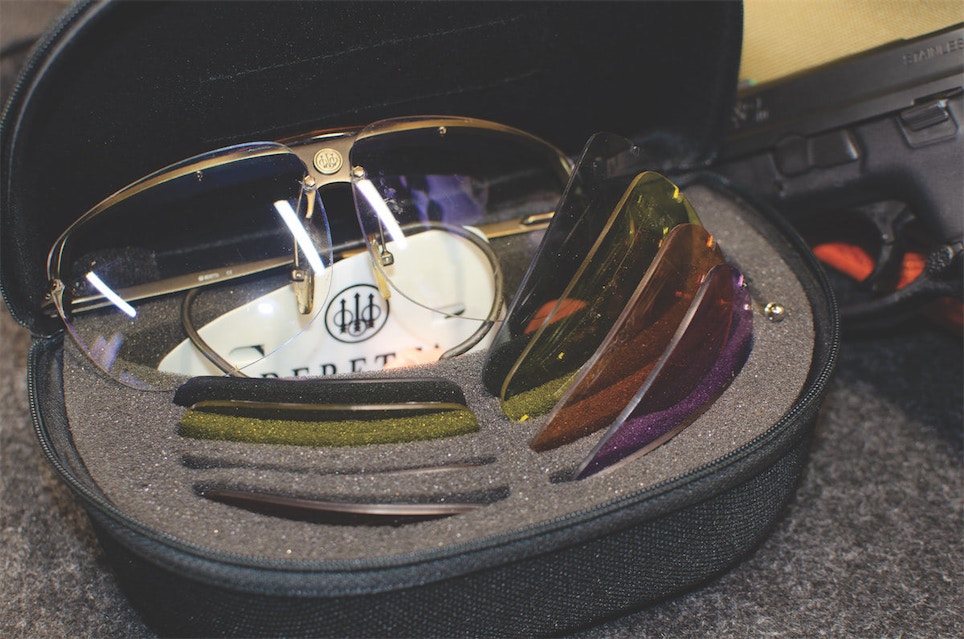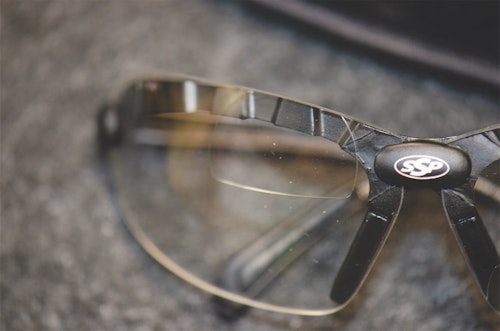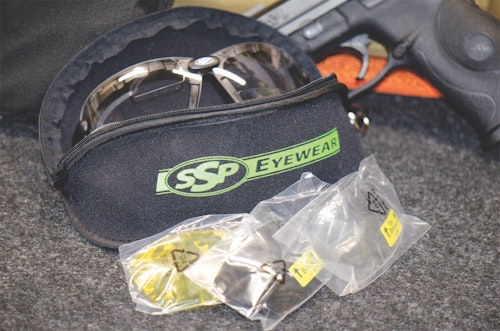Every customer in your store needs proper hearing and eye protection. When selling a gun, eye and hearing protection should always be on the list of topics covered — especially with new shooters.
It is surprising how many people have no idea about protective equipment and end up on the firing line with nothing more than a pair of sunglasses or prescription eyewear. That’s a recipe for disaster. It’s up to you, as the expert, to educate them and guide them to what they need and why.
Customers need to know the dangers. It doesn’t matter if the range is indoor or out; the potential hazards are the same. Ricochets, dust and debris from exploding targets, bits of clay pigeons, and even flying gun parts can cause serious injury. Yes, I said flying gun parts. It doesn’t take a deep search to find pictures of guns that have experienced a catastrophic failure on the firing line. That’s why quality protective gear is a must.
All eye protection sold in the U.S. is rated by the American National Standards Institute to ensure it meets specific minimum standards based on intended use. This includes face shields, goggles, welding glasses and more. Those that pass testing are given the Z87+ safety rating. Since we’re specifically interested in shooting sports, let’s look at what ANSI testing for shooting glasses looks like.
ANSI’s evaluations are designed to replicate extreme events in a laboratory. They do this by subjecting the glasses to a two-part test: the high-mass impact and the high-velocity impact.
The high-mass impact simulates a large, heavy object hitting the glasses. A 500-gram pointed spike is dropped on the lens from a height of at least 48 inches. If it passes the first part, it then undergoes the high-velocity impact test. This involves shooting a 1/4-inch steel ball at the lens at a speed of 102 mph. Both are pass/fail tests. There is no middle ground. Passing means that they survive both trials with no fractures or cracks on either the lens or the frame.
Those that pass are etched or stamped with that the Z87+ marking. Sometimes the rating is designated as Z87.1 rather than Z87+. This refers to ANSI Z87.1-2020, which is the latest standard. You might also see Z87-2+. The “-2” indicates that the lenses are prescription eyewear in addition to being ANSI approved. Note that if the rating is Z87 with no further markings, the glasses are not rated against impact. Imagine the same tests performed on a pair of standard sunglasses, and you’ll see the importance of educating your customers.
When ANSI updated its standards in 2020, a new rating was added. They are now advocating and measuring anti-fog properties of eye protection. That’s a welcome change since fogged glasses defeat the purpose of protective wear and increase the likelihood that people will go without protection because of it. Glasses that pass the anti-fog standard are designated with an “X” designation.
Rose-Colored Glasses Anyone?
Safety glasses aren’t just about protection. It’s now possible to protect your eyes from hazards while also decreasing haze, increasing visual acuity, and even making your targets or sights appear more defined. Let’s examine some of the possibilities in the world of colored lenses.
Looking through rose-colored glasses usually means that people are intentionally filtering out certain things they don’t want to see. Colored lenses allow shooters to do just that, but they’re not limited to rose-colored lenses. Varieties include a wide array of colors, and shadings within each color group. Specific colors filter out a particular segment of the spectrum to increase shooters’ ability to see their targets and sights more clearly. Here are some of the most common lens colors and the benefits of each.
Clear
Clear lenses are by far the most popular. They provide an unimpeded view by allowing the entire color spectrum and the maximum possible light to reach the shooter’s eyes. As a result, these are ideal for shooting under controlled lighting situations such as indoor ranges.
Yellow (or Orange)
Yellow lenses are probably the second most popular color. Slip a pair on your customer’s face and watch their reaction as the world takes on a different (more dramatic) hue. Yellow glasses are often the preferred choice when shooting outdoors because they improve clarity. By blocking blue light, they reduce the effects of haze, fog and cloudy conditions. They also help improve depth perception, which is critical when dealing with moving targets such as at a trap or skeet range.
Rose (Vermillion)
Rose lenses are great for customers with a red/green color deficiency. They bring out the detail of orange targets and sights and increase the clarity of black targets as well. They are an excellent choice for clay targets.
Amber
Amber lenses are perfect for cloudy days with reduced light. They also block blue light and help with clarity.
Purple
When the range has a backdrop composed of green brush, grass or trees, purple lenses are an excellent choice. They help by making orange targets stand out against the background.
Brown
Brown lenses are excellent at blocking UV rays and thus reducing eye strain while at the same time providing superb color contrast and glare reduction in bright conditions. They are great for highlighting brown or earth tones and shine when bird hunting.
Gray
Gray lenses don’t improve clarity or contrast, but they make an excellent choice for outdoor use in bright sunlight, and for shooters with increased light sensitivity. They reduce the overall light received while still allowing accurate and balanced color tones.
Note: Not everyone sees color the same way, so recommend that they experiment with different lenses to see what works best for them. Also, try to stick with the lighter shades in the different colors. Darker lenses let in less light and cause pupils to dilate, which impedes depth perception.
Why Not Have It All?
As you can see, the different colors offer your customers the ability to customize their eyewear based on their intended environment and shooting conditions. Don’t drag out a bunch of glasses, though. Instead, demonstrate the color varieties using a pair with interchangeable lenses. In the past, these types of glasses were pricey. That’s not the case any longer. There are multiple brands offering inexpensive sets with three, four, five and even six different sets of interchangeable lenses. As another benefit of multi-lens glasses, scratched lenses can be easily ordered and replaced if needed.
Corrected Vision Solutions
Customers who usually wear prescription eyewear or require reading glasses are not left out of the game. Corrective lenses are readily available, as are standard lenses with bifocal magnifications built-in. The latter are a blessing to those with aging eyes. If your customer wears reading glasses, bifocal magnifications placed at the top of the lenses are highly recommended. They allow good sight pictures without tilting the head up, as required with standard bifocals.
Take the Time
With so many options available, customers can pick their protective equipment to fit their individual needs. Unfortunately, many customers have no idea of the options open to them. That’s where you come in.
Take the time to evaluate customer needs and show them what equipment and accessories will help them. They will appreciate the advice and the time you spend with them. All of this leads to a safer and more enjoyable shooting experience for your customers, higher satisfaction ratings, and ultimately increased sales.








